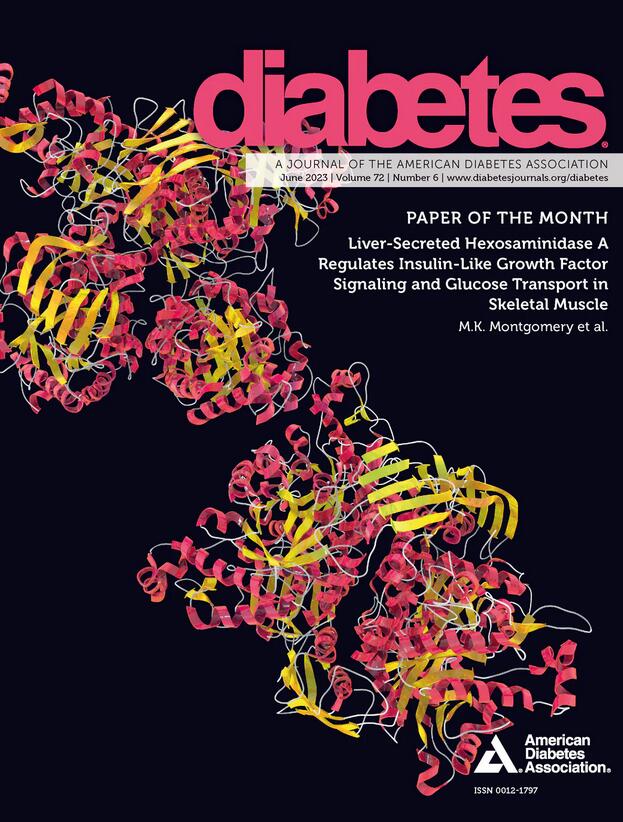SIRT6 Is a Key Regulator of Pancreatic β-Cell Survival and Function During Aging
IF 7.5
1区 医学
Q1 ENDOCRINOLOGY & METABOLISM
引用次数: 0
Abstract
Pancreatic β-cells undergo senescence and loss during aging; however, the underlying mechanisms remain incompletely understood. This study aimed to investigate what sirtuin 6 (SIRT6) does during β-cell aging. Pancreatic β-cell–specific Sirt6 transgenic (TgSIRT6) mice were generated for this study. DNA damage, cell death, and cell proliferation were analyzed in cell and mouse models. SIRT6 protein levels were decreased in pancreatic β-cells during aging. TgSIRT6 mice exhibited less DNA damage and cell death, including apoptosis, necroptosis, and pyroptosis, in β-cells than control mice. TgSIRT6 mice had increased total islet area and mass in pancreas compared with control mice. As a result, TgSIRT6 mice showed better glucose tolerance and glucose-stimulated insulin secretion than control mice. RRAD and GEM-like GTPase 2 (REM2), an endogenouse inhibitor of high-voltage–activated calcium channels, was negatively regulated by SIRT6. Knockdown of Rem2 in INS-1 cells partially rescued the SIRT6 deficiency– and palmitic acid–induced DNA damage, lipid peroxidation, and cell death. Rem2 β-cell–specific knockout mice had less DNA damage and cell death in β-cells than control mice. Our data suggest that SIRT6 is a critical antiaging factor in pancreatic β-cells and is a potential therapeutic target. ARTICLE HIGHLIGHTS Pancreatic β-cell function declines with age, but the underlying mechanism is poorly understood. In this study, we attempted to address how to reverse β-cell aging. Our data showed that sirtuin 6 (SIRT6) overexpression can reduce age-associated DNA damage, cell death, and functional decline in β-cells. Our findings suggest that improving Sirt6 gene expression and function may slow down β-cell decline in older patients.SIRT6是衰老过程中胰腺β细胞存活和功能的关键调节因子
胰腺β细胞在衰老过程中发生衰老和损失;然而,潜在的机制仍然不完全清楚。本研究旨在探讨SIRT6 (SIRT6)在β细胞衰老过程中的作用。本研究生成胰腺β细胞特异性Sirt6转基因(TgSIRT6)小鼠。在细胞和小鼠模型中分析了DNA损伤、细胞死亡和细胞增殖。胰腺β-细胞SIRT6蛋白水平随着衰老而降低。与对照小鼠相比,TgSIRT6小鼠β细胞的DNA损伤和细胞死亡(包括凋亡、坏死和焦亡)较少。与对照组小鼠相比,TgSIRT6小鼠胰腺总胰岛面积和质量增加。结果,TgSIRT6小鼠比对照小鼠表现出更好的葡萄糖耐量和葡萄糖刺激的胰岛素分泌。RRAD和gem样GTPase 2(一种高压激活钙通道的内源性抑制剂)受SIRT6的负调控。在INS-1细胞中敲低Rem2部分挽救了SIRT6缺乏和棕榈酸诱导的DNA损伤、脂质过氧化和细胞死亡。与对照组小鼠相比,Rem2 β细胞特异性敲除小鼠的DNA损伤和β细胞死亡较少。我们的数据表明SIRT6是胰腺β细胞中一个关键的抗衰老因子,是一个潜在的治疗靶点。胰腺β细胞功能随着年龄的增长而下降,但其潜在机制尚不清楚。在这项研究中,我们试图解决如何逆转β细胞老化。我们的数据显示SIRT6过表达可以减少与年龄相关的DNA损伤、细胞死亡和β细胞功能下降。我们的研究结果表明,改善Sirt6基因的表达和功能可能会减缓老年患者β细胞的衰退。
本文章由计算机程序翻译,如有差异,请以英文原文为准。
求助全文
约1分钟内获得全文
求助全文
来源期刊

Diabetes
医学-内分泌学与代谢
CiteScore
12.50
自引率
2.60%
发文量
1968
审稿时长
1 months
期刊介绍:
Diabetes is a scientific journal that publishes original research exploring the physiological and pathophysiological aspects of diabetes mellitus. We encourage submissions of manuscripts pertaining to laboratory, animal, or human research, covering a wide range of topics. Our primary focus is on investigative reports investigating various aspects such as the development and progression of diabetes, along with its associated complications. We also welcome studies delving into normal and pathological pancreatic islet function and intermediary metabolism, as well as exploring the mechanisms of drug and hormone action from a pharmacological perspective. Additionally, we encourage submissions that delve into the biochemical and molecular aspects of both normal and abnormal biological processes.
However, it is important to note that we do not publish studies relating to diabetes education or the application of accepted therapeutic and diagnostic approaches to patients with diabetes mellitus. Our aim is to provide a platform for research that contributes to advancing our understanding of the underlying mechanisms and processes of diabetes.
 求助内容:
求助内容: 应助结果提醒方式:
应助结果提醒方式:


